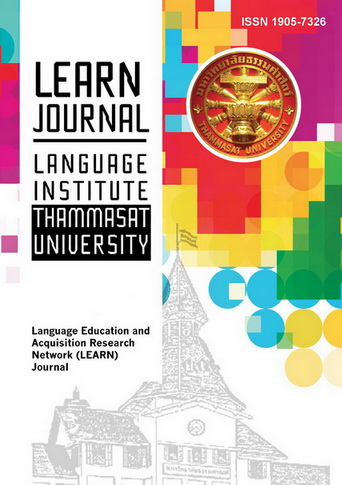A Contrastive Study of Rhetorical Move Structure of English Medium Instruction Lectures Given by Native English and Chinese Lecturers
Main Article Content
Abstract
This study aims to compare the rhetorical move structure of English Medium Instruction (EMI) lectures given by native English and Chinese lecturers. Two specialized corpora were therefore accordingly created with transcripts of twelve science-oriented lectures selected from MICASE and the BASE corpus and twelve science-oriented EMI lectures collected at a Chinese university, respectively. Adopting the Swalesian genre analysis framework, this study examines the moves/steps of EMI lectures in the two corpora. Then, the conventionality and frequency of moves/steps were quantified and analyzed to capture statistical variations. In addition, semi-structured interviews were conducted with four Chinese EMI lecturers to probe into their discursive practices from an emic perspective. Statistical variations were apparent in several moves and steps, which could be mainly attributed to Chinese EMI lecturers’ concern for the program quality, dense course syllabus requirements, a lack of specific English for EMI teaching, as well as the emergence and influence of new social media. The study argues for well-targeted teacher training for non-native English lecturers and more teacher autonomy in course syllabus design.
Article Details
References
Bolton, K., & Botha, W. (2015). English in China’s universities: Past and present. World Englishes, 34(2), 190-210. https://doi.org/10.1111/weng.12133.
Chaudron, C., & Richards, J. (1986). The effect of discourse markers and the comprehension of lectures. Applied Linguistics, 7(2), 113-127. https://doi.org/10.1093/applin/7.2.113.
Cheng, S. W. (2012). “That’s it for today”: Academic lecture closings and the impact of class size. English for Specific Purposes, 31(4), 234-248. https://doi.org/10.1016/j.esp.2012.05.004.
Dearden, J. (2014). English as a medium of instruction-a growing global phenomenon.https://www.britishcouncil.org/sites/default/files/e484_emi_-_cover_option_3_final_web.pdf
Deroey, K. L., & Taverniers, M. (2012). Just remember this: Lexicogrammatical relevance markers in lectures. English for Specific Purposes, 31(4), 221-233. https://doi.org/10.1016/j.esp.2012.05.001.
Flowerdew, J., & Wan, A. (2010). The linguistic and the contextual in applied genre analysis: The case of the company audit report. English for Specific purposes, 29(2), 78-93. https://doi.org/10.1016/j.esp.2009.07.001.
Flowerdew, L. (2016). A genre-inspired and lexico-grammatical approach for helping postgraduate students craft research grant proposals. English for Specific Purposes, 42, 1-12. https://doi.org/10.1016/j.esp.2015.10.001.
Freeman, D. (2017). The Case for teachers’ classroom English proficiency. RELC Journal, 48 (1), 31–52. https://doi.org/10.1177/0033688217691073.
Freeman, D., Katz, A., Garcia Gomez, P., & Burns, A. (2015). English-for-teaching: Rethinking teacher proficiency in the classroom. ELT Journal, 69(2), 129–39. https://doi.org/10.1093/elt/ccu074.
Hirano, E. (2009). Research article introductions in English for specific purposes: A comparison between Brazilian Portuguese and English. English for Specific Purposes, 28(4), 240-250. https://doi.org/10.1016/j.esp.2009.02.001.
Holmes, R. (1997). Genre analysis and the social sciences: An investigation of the structure of research article discussion sections in three disciplines. English for Specific Purposes, 16(4), 321-337. https://doi.org/10.1016/S0889-4906(96)00038-5.
Hu, G. (2009). The craze for English-medium education in China: Driving forces and looming consequences. English Today, 25(4), 47–54. https://doi.org/10.1017/S0266078409990472.
Hu, G., & Duan, Y. (2018). Questioning and responding in the classroom: A cross-disciplinary study of the effects of instructional mediums in academic subjects at a Chinese university. International Journal of Bilingual Education and Bilingualism, 22(1), 1-19. https://doi.org/10.1080/13670050.2018.1493084.
Hu, G., & Lei, J. (2014). English-medium instruction in Chinese higher education: A case study. Higher Education, 67(5), 551-567. https://doi.org/10.1007/s10734-013-9661-5.
Hu, G., & McKay, S. L. (2012). English language education in East Asia: Some recent developments. Journal of Multilingual and Multicultural Development, 33, 345–362. https://doi.org/10.1080/01434632.2012.661434.
Hu, G., Li, L., & Lei, J. (2014). English-medium instruction at a Chinese University: Rhetoric and reality. Language Policy, 13(1), 21-40. https://doi.org/10.1007/s10993-013-9298-3.
Kanoksilapatham, B. (2005). Rhetorical move structure of biochemistry research articles. English for Specific Purposes, 24(3), 269-292. https://doi.org/10.1016/j.esp.2004.08.003.
Kanoksilapatham, B. (2011). Civil engineering research article Introductions: Textual structure and linguistic characterization. The Asian ESP Journal, 7(2), 55-84.
Kanoksilapatham, B. (2015). Distinguishing textual features characterizing structural variation in research articles across three engineering sub-discipline corpora. English for Specific Purposes, 37, 74-86. https://doi.org/10.1016/j.esp.2014.06.008.
Kwan, B. S. C. (2006). The schematic structure of literature reviews in doctoral theses of applied linguistics. English for Specific Purposes, 25, 30-55. https://doi.org/10.1016/j.esp.2005.06.001.
Lee, J. J. (2009). Size matters: an exploratory comparison of small-and large-class university lecture introductions. English for Specific Purposes, 28(1), 42-57. https://doi.org/10.1016/j.esp.2008.11.001.
Lee, J. J. (2016). “There’s intentionality behind it…”: A genre analysis of EAP classroom lessons. Journal of English for Academic Purposes, 23, 99-112. https://doi.org/10.1016/j.jeap.2015.12.007.
Nwogu, K. N. (1997). The medical research paper: Structure and functions. English for specific purposes, 16(2), 119-138. https://doi.org/10.1016/S0889-4906(97)85388-4.
Olsen, L. A., & Huckin, T. H. (1990). Point-driven understanding in engineering lecture comprehension. English for Specific Purposes, 9(1), 33-47. https://doi.org/10.1016/0889-4906(90)90027-A.
Ozturk, I. (2007). The textual organisation of research article introductions in applied linguistics: Variability within a single discipline. English for Specific Purposes, 26(1), 25-38. https://doi.org/10.1016/j.esp.2005.12.003.
Pho, P. D. (2008). Research article abstracts in applied linguistics and educational technology: A study of linguistic realizations of rhetorical move structure and authorial stance. Discourse Studies, 10, 231-250. https://doi.org/10.1177/1461445607087010.
Richards, J. C. (2017) Teaching English through English: Proficiency, pedagogy and performance, RELC Journal, 48 (1), 7–30. https://doi.org/10.1177/0033688217690059.
Simpson-Vlach, R. C., & Leicher, S. (2006). The MICASE handbook: A resource for users of the Michigan corpus of academic spoken English. University of Michigan Press.
Swales, J. M. (1990). Genre analysis: English in academic and research settings. Cambridge University Press.
Swales, J., & Feak, C. (2000). English in today’s research world: A writing guide. University of Michigan Press.
Thompson, S. E. (1994). Frameworks and contexts: A genre-based approach to analyzing lecture introductions. English for Specific Purposes, 13(2), 71-86. https://doi.org/10.1016/0889-4906(94)90014-0.
Wannaruk, A., & Amnuai, W. (2016). A comparison of rhetorical move structure of applied linguistics research articles published in international and national Thai journals. RELC Journal, 47(2), 193–211. https://doi.org/10.1177/0033688215609230.
Yang, R-Y. & D. Allison (2003). Research articles in applied linguistics: moving from results to conclusions. English for Specific Purposes, 22(4), 365-385. https://doi.org/10.1016/S0889-4906(02)00026-1.
Young, L. (1994). University lectures - macro-structure and micro-features. In J. Flowerdew (Ed.), Academic listening: Research perspectives (pp. 159-175). Cambridge University Press.


